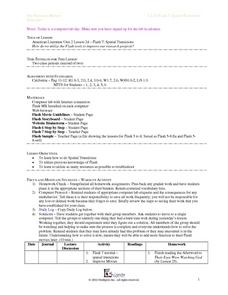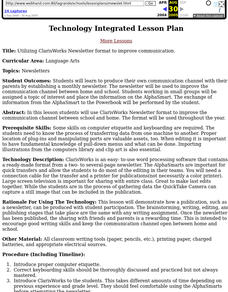EngageNY
Developing Reading Fluency: Beginning the End of Unit 2 Assessment
Third graders continue to develop their reading fluency in preparation for their assessment in the tenth lesson plan of this unit. Young readers are provided with a short passage on Helen Keller, which they use while working in pairs...
Carolina K-12
Factors of Production and Economic Decision-Making
Class members begin this engaging economics activity by listing all the resources used in producing a car and using that example to draw parallels to the four primary factors of production: capital goods, labor, natural resources, and...
National Endowment for the Humanities
David Walker vs. John Day: Two Nineteenth-Century Free Black Men
What was the most beneficial policy for nineteenth-century African Americans: to stay in the United States and work for freedom, or to immigrate to a new place and build a society elsewhere? Your young historians will construct an...
University of North Carolina
The Narrative of the Life of Frederick Douglass, an American Slave
After reading excerpts from Frederick Douglass' autobiography, pupils will draw on what they've learned about the cruelty of slavery to write and present an anti-slavery speech or editorial.
American Chemical Society
Protons, Neutrons, and Electrons
Atomic bombs harness the power in the nucleus of an atom, creating devastating power and damage. Classes review parts of an atom by charging a piece of plastic and holding it near their fingers, discussing what is happening and why....
American Chemical Society
Changing State: Evaporation
Why do experiments require a control? Guide scholars through designing an experiment to see what they can do to evaporate water faster with a lesson that stresses the importance of controlling all variables. The second activity allows...
American Chemical Society
Finding Volume: The Water Displacement Method
We have formulas for finding the volume of geometric shapes, but what if the shape is irregular? Lesson describes how to find volume through water displacement. After a demonstration, scholars practice in small groups. Then analysis...
American Chemical Society
What is Density?
Density: the reason a giant pumpkin will float, but a tiny cranberry won't. Lesson begins with a demonstration of two of the same-sized cubes having different densities. Then pupils take eight cubes, each of the same size, and have to...
American Chemical Society
Controlling the Amount of Products in a Chemical Reaction
Everyone enjoys combining baking soda and water. Here is a lesson that challenges scholars to analyze the reaction three different ways — the real substances, the chemical equation, and the molecular models. Class members experiment to...
American Chemical Society
pH and Color Change
Did you know strong bases can feel slippery and slimy? Lesson allows scholars to practice using the pH scale to identify acids and bases and their strengths. By changing the concentration of an acid and a base, they create the entire...
PhET
Isotopes and Atomic Mass
Some isotopes are unstable, or radioactive, meaning they will decay over time and turn into another isotope or stable element. In the interactive simulation, participants manipulate elements to create isotopes and gather information....
American Chemical Society
Temperature Affects Density
Different substances can have different densities, but can the same substance have different densities? Lesson explores the effect of temperature on the density of water. Extension idea connects the concept of how melting ice in lakes...
Alabama Learning Exchange
Explore the Transformations of Linear and Absolute Value Functions Using Graphing Utilities
Students explore the concept of transformations. For this transformation lesson, students use an applet that is an interactive absolute value graph applet. Students manipulate the applet to examine the change in the function and how it...
Curated OER
How Do We Utilize Flash Tools to Improve Research?
Students complete Flash Movies. They identify how to use the Push Button Component in Flash and how to create Scenes. They demonstrate how to use buttons to move within a Flash Movie and finish movies for their Research Projects.
Curated OER
Utilizing ClarisWorks Newsletter
Students produce their own communication channel with their parents by establishing a monthly newsletter. The newsletter will be used to improve the communication channel between home and school. Student groups are assigned a topic of...
Curated OER
How Are Polymers Utilized in Everyday Life?
Young scholars identify the different types of polymers. In this chemistry lesson, students research information about an area of polymer science they chose. They create a PowerPoint presentation to share their findings in class.
Curated OER
Who's Got Your Power
Learners examine and map local sources of energy. They conduct Internet research on their local utility company, identify where their utility company obtains energy, graph the data, and label a map of power plant locations in their state.
Curated OER
Shopping With Basic Math
Fifth graders utilize basic math computation on a pretend shopping trip to obtain everyday items and services such as an oil change and grocery shopping.
Curated OER
Muscle Journal
Students study a muscle journal which includes a front and back picture of the following muscles: triceps, biceps, abdominal muscles, quadriceps, hamstrings. They locate biceps on themselves and on others. Next, they utilize their...
Curated OER
WORKING HARD OR HARDLY WORKING
Students research a specific career and have the opportunity to gain new information, utilize electronic technology, and write a grade-level appropriate paper.
Curated OER
Creating Fitness Goals
Students create a fitness goal to include one of the following: muscle building, cardiovascular development or healthful diet. They utilize a daily calendar to record progress. They utilize the Internet to research proper ways to reach...
Curated OER
Nature and Fintess Trail
High schoolers investigate how humans impact the environment and compile an organism database into an e-book field guide. They name muscle groups and develop specific exercises to strengthen these groups. Students utilize technology for...
Curated OER
Researching an Author
Students research works by a contemporary author of their
choice, choosing one in particular upon which to focus, conducting research
relating to that work. They create a brochure utilizing Microsoft Publisher then share their brochure...
Curated OER
Cultural Lit. 40: Native American Self Determination
Students list main event in historical sequence of Self Determination after receiving direct instruction, reading selected texts and working in group structures. They take notes utilizing note-taking frames to list main events in...
Other popular searches
- Electric Utility
- Calculator Utility
- Diminishing Marginal Utility
- Marginal Utility
- Utility of an Object
- Risk Utility Analysis
- Marketing Utility
- Economic Utility
- Lessons Paying Utility Bills
- Form Utility
- Sports Marketing Utility
- Hometown Utility Data

























